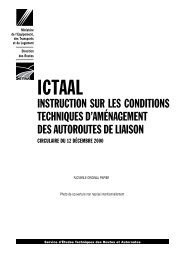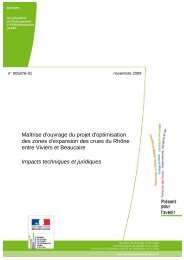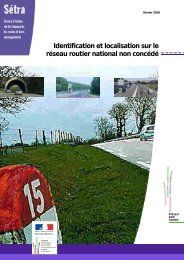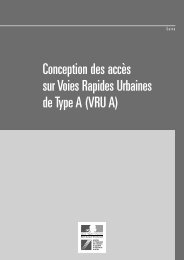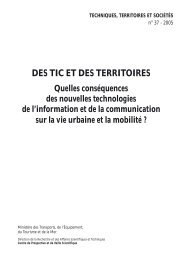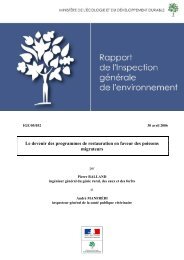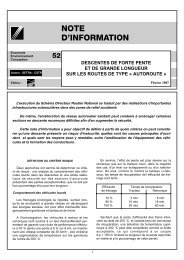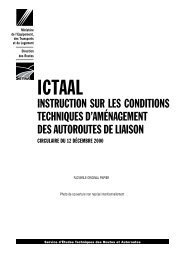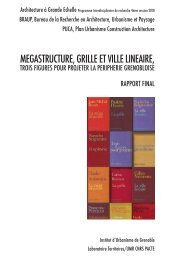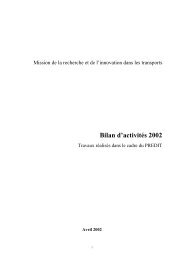Daniel Kaplan - Portail documentaire du Ministère de l'Ecologie
Daniel Kaplan - Portail documentaire du Ministère de l'Ecologie
Daniel Kaplan - Portail documentaire du Ministère de l'Ecologie
You also want an ePaper? Increase the reach of your titles
YUMPU automatically turns print PDFs into web optimized ePapers that Google loves.
232<br />
Design<br />
The fact that <strong>de</strong>sign has been characterized by<br />
an arrow pointed from virtual to physical space,<br />
does not imply that the latter is seen as being simply<br />
impacted upon, leave alone <strong>de</strong>termined by virtual<br />
space. Design rather means a search for new spatial<br />
(planning) concepts, inspired by ICT.<br />
Since we set out earlier on a search for new<br />
spatial planning concepts [Drewe, 1988], some<br />
progress has been ma<strong>de</strong> [Drewe 2000b]. The<br />
findings to date can be summarized as follows.<br />
ICT constitutes a paradigm challenge that still<br />
meets with resistance from practitioners. This is,<br />
among others, related to the fact that there is no<br />
direct link between ICT and spatial structure and<br />
that the spatial impacts of the new technology still<br />
involve a high level of uncertainty.<br />
The main challenge is how to organize<br />
complexity in contrast to existing spatial concepts.<br />
Organized complexity means thinking in terms of<br />
multiple options rather an either/or solutions.<br />
Networks are the central concept, in line with<br />
the urbanism of networks, which is based on<br />
network thinkers in the history of urbanism as<br />
opposed to the mainstream of zonal thinkers. The<br />
network urbanism encompasses all kind of urban<br />
technology networks to which ICT is just the most<br />
recent addition. ICT and urban form is no longer an<br />
abstraction. There are emergent concepts such as<br />
the integrated metropolis. There are also quite a few<br />
classics that can provi<strong>de</strong> a source of inspiration for<br />
the 21 st century. But the emerging pattern language<br />
of electronic connections must tie in seamlessly to<br />
the pattern language for physical connections.<br />
A <strong>de</strong>sign studio has been created, <strong>de</strong>dicated to<br />
the “Network City” : http://www.networkcity.nl The<br />
approach adopted is one of <strong>de</strong>sign-oriented<br />
research aiming at possible futures as <strong>de</strong>sign can<br />
Paul Drewe<br />
<strong>de</strong>monstrate and visualize what could be. The<br />
future urban agglomeration is one of the test-beds.<br />
An integrated planning of land use and urban<br />
technology including ICT- needs to be <strong>de</strong>veloped.<br />
And urban ICT initiatives are to be stimulated as reallife<br />
experiments. There is a wi<strong>de</strong> range of possibilities.<br />
Of special importance are those initiatives that target<br />
the least-connected citizens to prevent them from<br />
“falling through the net” [Drewe, Fernan<strong>de</strong>z-<br />
Maldonado and Hulsbergen, 2001].<br />
Conclusion<br />
As said before, ICT constitutes a paradigm<br />
challenge that meets with resistance from practitioners<br />
such as urbanists or spatial planners,<br />
specialized in physical space. Yet it cannot be <strong>de</strong>nied<br />
any longer that the non-physical information space<br />
or virtual space is expanding rapidly. This even gives<br />
rise to hypes, myths and misleading (spatial)<br />
metaphors.<br />
Exploring the interactions of the physical and<br />
virtual space is a course of action midway between<br />
extremes. Visualization is closest to the traditional<br />
tra<strong>de</strong> whereas online planning/ <strong>de</strong>sign is already<br />
much more <strong>de</strong>manding. Both interactions start<br />
from the more familiar physical space.<br />
Moving to virtual space interacting with<br />
physical space, analysis and <strong>de</strong>sign (as they have<br />
been <strong>de</strong>fined here) require a consi<strong>de</strong>rable dose of<br />
innovativeness. In particular <strong>de</strong>sign the creation of<br />
new spatial concepts inspired by ICT is vital in<br />
reasserting the grounding powers of the traditional<br />
art of physical <strong>de</strong>sign.<br />
If ICT is not taken seriously and not <strong>de</strong>alt with<br />
professionally by practitioners, at the end of the day,<br />
Kohlhaas will be proven right in calling urbanism “a<br />
bastion of the <strong>de</strong>nial of reality”.



